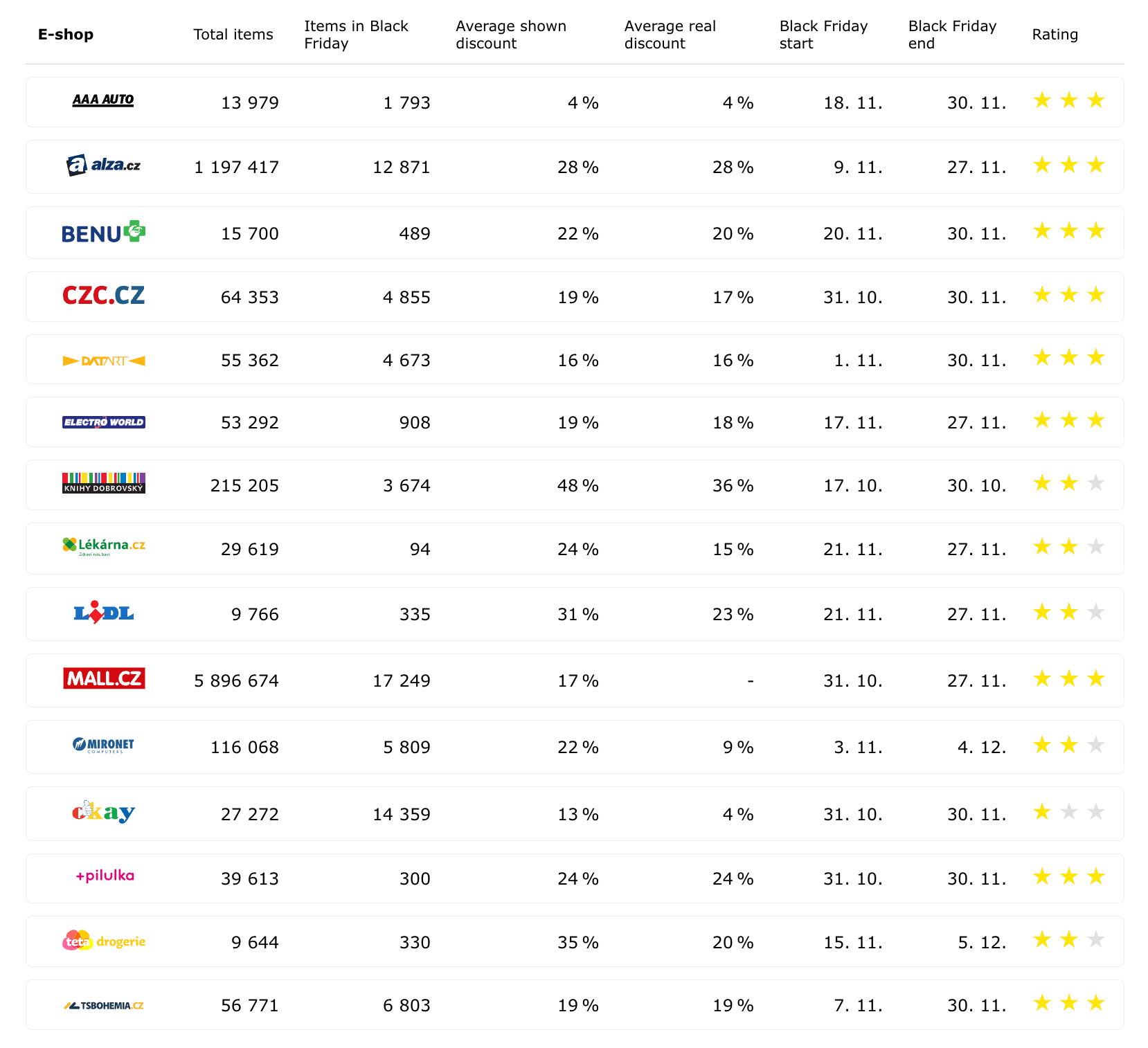This is a translation of the analysis written in Czech; you can read the original author's version of this article as well.
This year at Hlídač shopů (Shop Watcher), we were looking forward not only to Black Friday but also to the amendment to the Czech Consumer Protection Act, which would once and for all define clear rules for online retailers on how to calculate and display discounts. Unfortunately, this long-awaited piece of legislation (conveniently) still has a few weeks to come into force, making this Black Friday the last chance for e-commerce stores to artificially inflate their discounts without any legal repercussions. So, how did they handle it this year?
Surprisingly well. Most e-commerce retailers that launched a Black Friday campaign in 2022 decided to comply and displayed discounts in line with the new rules.
Alza.cz and CZC.cz, which already displayed real discounts last year, were joined by other retailers that, at least for Black Friday category items, already follow the new price reduction policy. The companies in question are Mall.cz, TSBohemia.cz, Datart.cz, ElektroWorld.cz, Pilulka.cz, Benu.cz, and AAAauto.cz (see retailers with a 3-star rating in the dashboard below). The shadow of the new law already had an impact on these e-commerce shops: the reported discounts were practically half of what they were last year.
Another group is online retailers that are ostensibly trying to switch to the new rules but, if we take a look at the EU guidelines, are not quite in line with them yet. Typical reasons for this are not displaying the mentioned minimum price before the campaign actually launches or its incorrect calculation. Cases in point include BooksDobrovsky.cz, Notino.cz, Lekarna.cz, Lidl.cz, Mironet.cz, and TetaDrogerie.cz and they received 2 stars in our rating.
Our last special case is Okay.cz, which traditionally performs very poorly in our book, with average real discounts this year rounding up to only 4% (even after including "Additional discounts" within their Black Friday campaign).
Before we move on to practical examples, let's take a look at the overall numbers:

*Due to issues with data, we were not able to calculate the average real discount for Mall.cz. However, the discounts were calculated according to the new rules, and the real discounts corresponded to the ones reported.
Considering the overview above and last year's analysis of the Czech e-commerce market, here’s our brief summary:
- average real discounts for items in the Black Friday sale category ranged between 15 and 30%, which was the same as last year.
- online shops that switched to the new policy reported real discounts that were also way less bold compared to last year. In some cases, half of what they were (Mall.cz 17% in 2022 vs. 32% in 2021, Datart 16% in 2022 vs. 30% in 2021).
- Black Friday offers this year included a similar proportion of items as in 2021, mostly up to 10% of the total offer (besides Okay.cz, which included half of their total offer in their Black Friday sale).
- Black Friday campaigns typically lasted through November, in some cases multiple times in a row.
New law coming into force
The amendment to the Czech Consumer Protection Act based on the EU Directive has already completed the approval process. On November 23, 2022, it was sent for publication, which should not take long. After the publication, the new policy should come into force within 30 days - so around the turn of the year 2023. E-commerce retailers, therefore, have a short time to adjust and fine-tune their systems to be ready for the New Year Sale period, which, hopefully, will already be running under the new law.
Let's recall the main part of the amendment that online stores need to prepare for in terms of sale campaigns - the calculation of discounts (translation of the Czech amendment follows):
1) Discount on the product price must contain information on the lowest price for which the product was offered and sold by the seller
a) in the 30 days before the price reduction;
(b) if the product has been on offer for less than 30 days, from the moment the product was initially offered and sold until the price reduction; or
c) in the 30 days before the initial price reduction, in case the seller chooses to increase the discount gradually.
(2) Paragraph 1 shall not apply to perishable goods or products with a short shelf life.
In addition to the text of the Act itself, there are also the aforementioned guidelines on the interpretation and application of the EU Directive. These guidelines describe the objectives of the Directive in detail, including rules for specific types of cases, such as discount codes, loyalty cards, additional reference prices, etc. We will be referring to these guidelines further in the text.

Some are not ready for the change
In our 2022 analysis, we came across lots of discounts that clearly do not comply with the new discount calculation policy. For example, see Trevi XR 9A5 Bluetooth speaker on Okay.com. This item has been listed in Black Friday sale with after discount price of CZK 803. The price before this additional 10% discount was CZK 892, and the crossed-out manufacturer's recommended price was CZK 1499.
However, for practically the whole of October before Black Friday, Okay.cz was selling this item for CZK 600, so for the Black Friday sale, the price actually went up by 36%. According to the new discount policy, the seller must show the lowest selling price indicated the last 30 days prior to the sale (in this case, CZK 590) and calculate the price reduction (or, in this case, the price increase) from it.
Another similar case is the ARCTIC MX-4 2019 on Mironet.cz. The product is included in the “Blue Friday” campaign, and its price changes every day. For example, on November 27, it was CZK 76 with a 41% discount (see the crossed-out price of CZK 128). However, for practically the whole year, this product was being sold at CZK 75, and the mentioned CZK 128 has only been around for a few days. The minimum price before Black Friday was CZK 73 (in reality, the price went up again).
Mironet.cz itself states on the website:
“The stated discounts were calculated from the original price, with the original price being the price at which the merchant sold the product on October 1, 2022.”
This statement still allows this online retailer to create artificial discounts, as in this case. Moreover, according to our data, on October 1, 2022, this item was sold for CZK 75.
Once again, Lidl.cz managed to surprise us with an interesting trick. The secret to the trick is that the item gets a price boost for one day only, and then this price is used as a reference for the Black Friday discount. For example, Crivit Golf Bag was offered during Black Friday for CZK 1999, with a declared 50% discount and a reference price of CZK 3999. However, Lidl.cz was selling this product for CZK 3999 for only two days this year - June 16 and September 16.
In the worst-case scenario, during Black Friday, you may come across an item with a boosted price. For example, this ERNESTO Multifunctional Kitchen Bowl is listed in the Black Friday sale for CZK 129, which is 86% more expensive than its original price.
Interpretations of the new rules
According to our data, this year KnihyDobrovsky.cz was at the top of our charts with the largest real discounts. However, the declared discounts were still larger than the real ones due to the shop’s calculation method. KnihyDobrovsky.cz traditionally calculates the discount from the stated retail prices, which at times can vary for the same product within one online store. An example is the That Guy book, sold during Black Friday for CZK 99 with a real discount of 68%.
In preparation for the new rules, this shop now added the feature of transparent price development, and it also doesn’t include the discount percentage in its price tag. However, in the product overview, the crossed-out retail price is still shown and referred to when calculating the discount: You will save CZK XXX (in this case, “You will save CZK 300”, which corresponds to a 75% discount).
According to the EU guidelines on the interpretation of the Directive, this note also counts as a price reduction announcement’. Specifically:
Article 6a applies to promotional statements by the seller that it has reduced the price that it charges for the good(s). For example, a price reduction could be announced:
— In terms of percentage (%), e.g., ‘20 % off’ or a specific amount, e.g., ‘EUR 10 off’;
— by indicating a new (lower) price together with the indication of the previously applied (higher) price. The previous price can be presented in a crossed-out form. E.g., ‘now EUR 50, was EUR 100’ or ‘EUR 50/
Thus, according to the new policy, the e-commerce shop must display the lowest selling price 30 days before the event and calculate “Save XXX CZK” from it.
The display of the retail or other reference price is allowed, but now the lowest selling price must also be displayed, and this must be clearly communicated to the customer:
In general, the manner in which any such other reference prices are presented and calculated is subject to the UCPD. In this respect, traders must always make sure that it is clear to the consumer what the other indicated reference prices represent.
In addition, KnihyDobrovsky.cz has prepared two sale campaigns in a row: Blekfrajdejíček (small Black Friday), October 17-30, and Black Friday, November 24-27. In our statistics, we only show data for the first event. But we also took a look at the second one, where the average of real discounts is around only 5%. This is again due to the new lowest price rule that has to be shown the last 30 days before the event - the first Blekfrajdejíček does fall into this period, which sets its reference price sometimes even lower than the Black Friday price. See, for example, the Voices in the Snow book. During the Black Friday sale (from November 25), this book cost CZK 249, which is 151% more than during Blekfrajdejíček, when it cost just CZK 99 (until October 30).
However, KnihyDobrovsky.cz is preparing for the new law, and according to Adam Pýcha, they should be able to complete the preparations in time:
"During 2022, we have deployed a number of adjustments that make it much easier for customers to navigate prices and special discounts. We intend to continue to do this based on the current amendment to the law. By the end of the year, there will be only minor adjustments to reviews; product listings will be updated, so they no longer contain any discount information, and information on the lowest selling price of the product in the last 30 days will be added to the product detail. We have also set new internal rules for communicating discounts in marketing campaigns to bring everything in line with the amended law."
Discount codes are another specific case. For example, Notino.cz offered a discount code black for this year's Black Friday, which reduced the price of selected products by 15 to 40%.
The problem lies in not displaying the lowest selling price before the promotion event. According to the interpretation guidelines, it must be displayed even in the case of discount codes, which are publicly available:
— ‘Today 20 % off when using the code XYZ’; or
— This weekend, 20 % off everything for loyalty members only’ where the code/the loyalty program is accessible/used by many or the majority of customers.
In these cases, the trader must comply with the requirements of Article 6a, i.e., ensuring that the ‘prior’ price for all the goods concerned is their lowest publicly available price in the last 30 days (see section 2.1. on general price reduction announcements).
Another interesting strategy we’ve encountered with several online retailers during this year's Black Friday was listing a product in a Black Friday promotion without any discount shown, for example, on Mall.cz:
The item is not actually discounted, the retail prices are no longer displayed, and there’s no discount shown. However, the price goes together with the tag “Black Friday - special price ends in 3 days”.
This is also what the EU guidance mentions:
In this case, according to Mall.cz spokeswoman Pavla Hobíková, it was an error that was promptly corrected (this affected dozens of items).
Minor differences in the methodologies
Even for e-commerce retailers that have already honestly transitioned to the new rules, in some specific cases, we have small disagreements about the accuracy of the current discount.
One of the cases is the gradual increase of the discount as the sale campaign progresses. In this case, the new rules allow you to refer to the lowest selling price before the first discount. Online retail shops are now taking different approaches to this. For instance, Alza.cz recalculates the reference (crossed-out) price even when the discount is subsequently increased. Thus, their declared discounts were even slightly lower than the real ones calculated by us.
CZC.cz recalculates the minimum price every day compared to the one 30 days ago, as opposed to calculating the minimum price at the start of the discount event. This also brings about discrepancies with the standard rules. However, according to CZC.cz's statement, they plan on switching to the standard calculation.
Another problem area is the time validity of the discount. Within the Black Friday promotion, most e-commerce retailers correctly stated the exact time period of the discount promotion. However, if the online shop chooses to maintain the discount after Black Friday ends, it can continue displaying it (according to the guidelines). However, this must not be for too long in order not to constitute misleading practice:
— excessively long periods during which price reductions apply compared to the period during which the goods are sold at a price without price reduction;
— advertising a reduction of, for example, ‘up to 70 % off’ when only a few of the items are reduced by 70 %, and the rest are reduced at a significantly lower percentage.
We will address the alignment of methodologies in more detail in our next analysis, which we plan on releasing once the new legislation comes into force.
Assortment of items in the 2022 Black Friday sale
Out of curiosity, this year, we also looked into the product assortment in the Black Friday offer by category. For example, Alza.cz had over 12,000 products in the Black Friday offer this year, with the most listings in Computers & Laptops, Cosmetics, Perfumes & Accessories, and Large & Small Appliances:
Looking at the subcategories, most items were from:
- IT accessories (computers & laptops)
- Jewelry (cosmetics, perfumes, and accessories)
- Mobile Accessories (mobile phones, smartwatches, tablets)
- Headphones (TV, photo, audio-video)
- Books (books, music, movies, and vouchers)
These are typically products with a higher margin when they're sold at the regular price.
What's in store for us in the near future
Czech e-commerce retailers have one final month to adjust their systems to comply with the new discount calculation policy. By the end of the year, the Czech law should be published and come into force 30 days later. Most of the online shops we monitor communicate and keep an open dialog with Shop Watcher concerning the unusual cases mentioned above.
Shop Watcher manages an automatic daily audit for these online shops. Once the law amendment comes into effect, the data will show us exactly who follows the new policy and who chooses not to. And this counts for the whole assortment - some retailers had all their ducks in a row for the Black Friday sale but don't yet comply with the new rules for other promotional events.
Ever since 2017, a group of data enthusiasts from Apify, TopMonks and Keboola teams up to monitor the misleading practices taking place on the Czech online retail markets in late November. You can track their progress yourself in our Black Friday analyses from previous years: 2017, 2018, 2019, 2020, and 2021.








